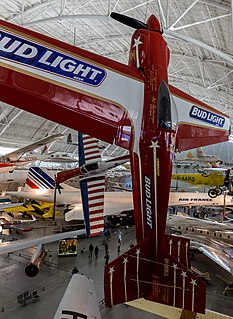
The Extra Flugzeugbau EA300 is a two-seat aerobatic monoplane capable of Unlimited category competition. It was designed in 1987 by Walter Extra, a German aerobatic pilot, and built by Extra Flugzeugbau.
The CAP Aviation CAP-23x family is a family of aircraft designed for competition aerobatics. The CAP 230 airframe was a direct development of the CAP 21 competition single seater strengthened to cope with a 300 hp (220 kW) 6-cylinder Lycoming AEIO-540 engine instead of the 200 hp (150 kW) original 4-cylinder Lycoming AEIO-360.

The Pitts Special is a series of light aerobatic biplanes designed by Curtis Pitts. It has accumulated many competition wins since its first flight in 1944. The Pitts biplanes dominated world aerobatic competition in the 1960s and 1970s and, even today, remain potent competition aircraft in the lower categories.

The Extra 200 is a two-seat, tandem arrangement, low-wing aerobatic monoplane with conventional (taildragger) landing gear fully capable of Unlimited category competition, built by Extra Flugzeugbau.

The Citabria is a light single-engine, two-seat, fixed conventional gear airplane which entered production in the United States in 1964. Designed for flight training, utility and personal use, it is capable of sustaining aerobatic stresses from +5g to -2g. Its name spelled backwards, "airbatic", reflects this.

The American Champion 8KCAB Decathlon and Super Decathlon are two-seat fixed conventional gear light airplanes designed for flight training and personal use and capable of sustaining aerobatic stresses between +6g and −5g. The Decathlon entered production in the United States in 1970 as a more powerful and stronger complement to the American Champion Citabria line of aircraft.

The Mudry CAP 10 is a two-seat training aerobatic aircraft first built in 1970 and still in production in 2007. The plane was developed from the Piel Super Emeraude and was born as the CP100. The name changed to CAP 10, CAP for 'Constructions Aéronautiques Parisiennes'. The CAP 10 was manufactured by Mudry in Bernay, France, bought by CAP Industries which then became Apex Aircraft. Following the bankruptcy of Apex in 2008, rights to produce spares were awarded to Dyn'Aviation. After the bankruptcy of DynAero in 2012, manufacture of spares was taken over by CEAPR in Darois.

The Hirth Hi 27 Acrostar was designed by Arnold Wagner to win aerobatic competitions, in part by having handling independent of orientation, upright or inverted. A single engine, single seat low-wing monoplane, it was built in West Germany by Wolf Hirth GmbH in the early 1970s, and dominated Championships for a brief period.

The Dyn'Aéro CR.100 is a French kit built single engine, two-seat monoplane, developed in the 1990s and intended as both an aerobatic trainer and a tourer, primarily for aero club use.
The Shober Willie II is an American two-seat sporting or aerobatic aircraft designed and built by Shober Aircraft Enterprises. The aircraft was designed to be sold as plans for amateur construction.

The Ultimate Aircraft 10 Dash is a Canadian single-seat sport and aerobatic biplane designed and built by Ultimate Aircraft Corporation of Guelph, Ontario.

The Coupé-Aviation JC-01 is the first of a series of very similar designs of two seat, single engine sports aircraft, amateur built from plans in France from 1976. These provided a range of engine sizes and undercarriage layouts, but total production was small.

The Speedtwin E2E Comet 1, originally named the Phillips ST1 Speedtwin, is a two-seat, twin engined aircraft designed in the UK to be capable of aerobatics and the only civil twin certified for intentional spinning. After a long development time, just two have been built.

national
The Rihn DR-109 is an American aerobatic homebuilt aircraft that was designed by Dan Rihn. The aircraft was supplied by Jim Kimball Enterprises of Zellwood, Florida and more recently by Ashcraft Aero Works of Aurora, Illinois in the form of plans. It was designed for competition aerobatics as well as a trainer for the Rihn DR-107 One Design.
The Giles G-200 is an American aerobatic homebuilt aircraft that was produced by AkroTech Aviation of Scappoose, Oregon. When it was available the aircraft was supplied as a complete ready-to-fly-aircraft or a kit for amateur construction. AkroTech Aviation went out of business and the design is no longer in production.

The Hatz Classic is an American homebuilt biplane, designed by Billy Dawson and produced by the Makelan Corporation of New Braunfels, Texas. The aircraft is supplied as a kit or, alternatively, in the form of plans for amateur construction.
The IIL IS-11 was an aerobatic, single seat glider, designed and built in Romania in 1959. It was built in small numbers.

The Extra EA-260 is a hand-built, single-seat aerobatic aircraft derived from the Extra 230 and first flown in 1986. Designed by aerobatic pilot Walter Extra based on the layout of the Extra 230, the Extra 260 is a higher performance version of its predecessor with 60% more power and 18% increase in weight. The first EA-260 was flown by Patty Wagstaff to victory in two U.S. National Aerobatic Championships, in 1991 and 1992, and then retired to the Smithsonian Institution when she obtained an Extra 300S.

The Loudenslager Laser 200 is a single place, mid wing, aerobatic monoplane designed and built by Leo Loudenslager. It is constructed of steel tubing and covered with Ceconite fabric.















